Studying in China on MIT’s Budget: a Guest Post by Saul W. ‘14 by Anna H. '14
Saul double-majored in Math and Asian & Asian Diaspora Studies.
Anna’s asked me to write for her blog. And, since this is Anna, there is some implicit obligation to be nice, or worse yet cheerful and upbeat. As you can see, this does not come naturally.
She wants me to write about China, where I’ve spent the last two summers and last two IAPs and where I’ll be heading off to again sooner or later. The first three trips were for Chinese language (funded by the always-generous Global Education Office) and the last for research on village reconstruction projects (funded by one of my departments, Foreign Languages & Literatures). The next year I’ll spend at Peking University, funded by the Chinese government. One of the great perks of being at MIT is that all this stuff gets paid for, as I’ll discuss more at the end of the post.
There is some reasonable question why an MIT math major spends so much time on the other side of the world. The answer is that I’m also an (er, the school’s sole) Asian and Asian Diaspora Studies major, half out of longstanding curiosity about the humanities and half as a coping mechanism to handle the eight humanities classes MIT requires. In this case Asia really means China, and I figure that if I’m studying China I should really learn the language, too. And where better to study a language and a country than by being there?
—————————–
Given that I take a lot of photos in China and hate to see them go to waste, I’m going to write this blog post as captions on photos.
My first trip to China began by crossing the border from Hong Kong into Shenzhen, one of the first cities to open up to foreign investment in the 1980s. It changed wholesale my image of China. I had always thought of China as a developing country, both thanks to news coverage and my academic training. Shenzhen, then, came as quite a shock: it did not fit with my image of a developing country. This photo is from a hill overlooking downtown (well, one of the downtowns), where an enormous Deng Xiaoping looks out over this strange building. It is, of course, the local government headquarters. They tend to be big and fancy, but this takes the cake for creativity. From this view at least, urban China looks developed.

It is not quite fair to those who label China as a developing country to leave it at a skyline photo. Chinese cities invest a great deal of effort and money in making their skylines look developed, and sometimes up close China is more legitimately a developing country. Shenzhen, which is itself at the highly developed end of the Chinese spectrum, is chalk full of “urban villages,” tenement housing crammed full of migrant workers. And although once you get off into the countryside, much of it still looks pretty developed thanks to migrants who invest heavily in their houses back home, there are serious exceptions where poverty prevails.
Here’s what goes on at street-level. (Shenzhen, again)
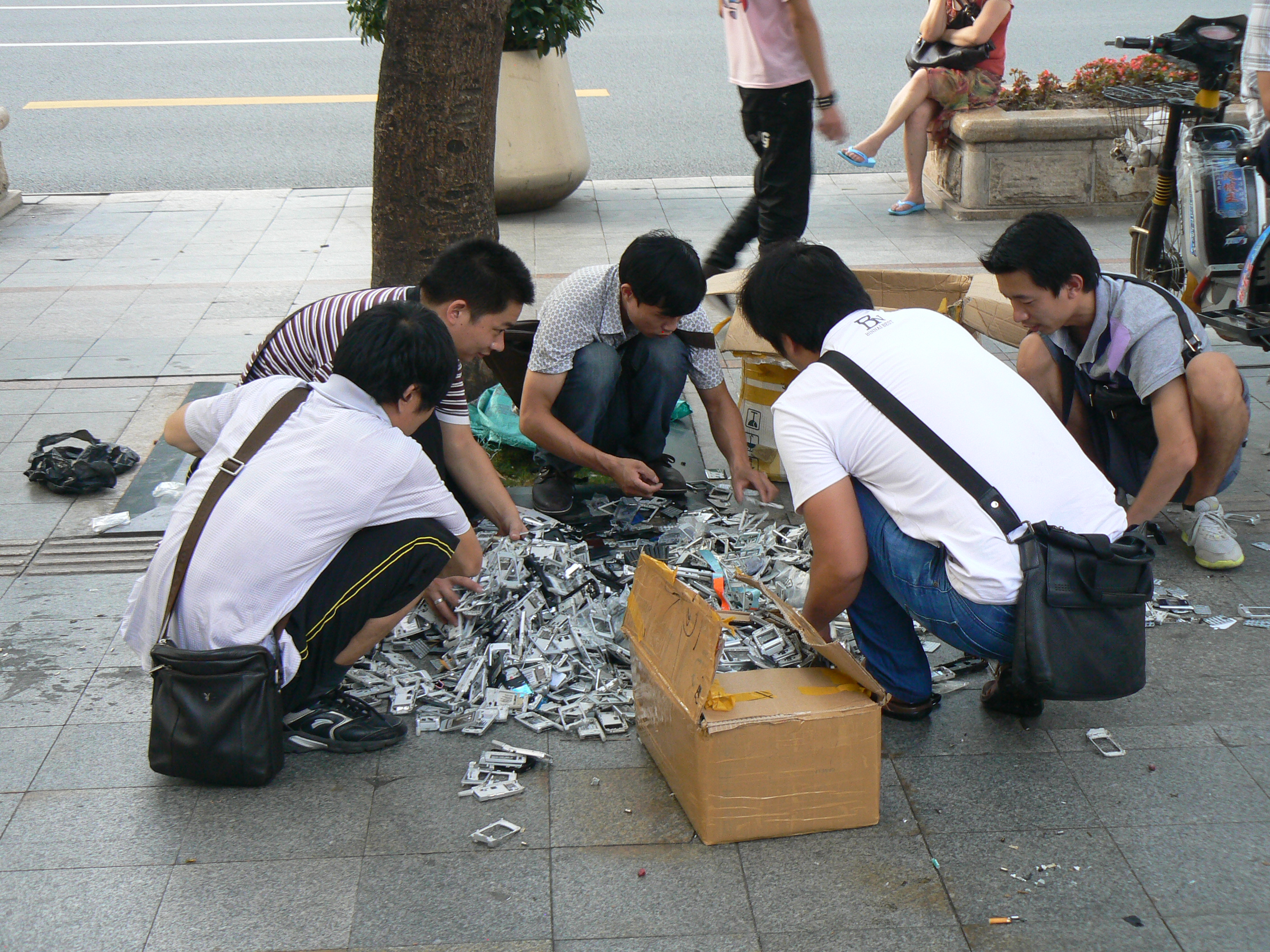
One of the stranger forms of street activity is package delivery. Unlike in the US, where packages show up at your door, you get to go hunting for your stuff in China. You get a little slip telling you where it is, and then you find the appropriate street-side heap of boxes from which to collect it. (Beijing)
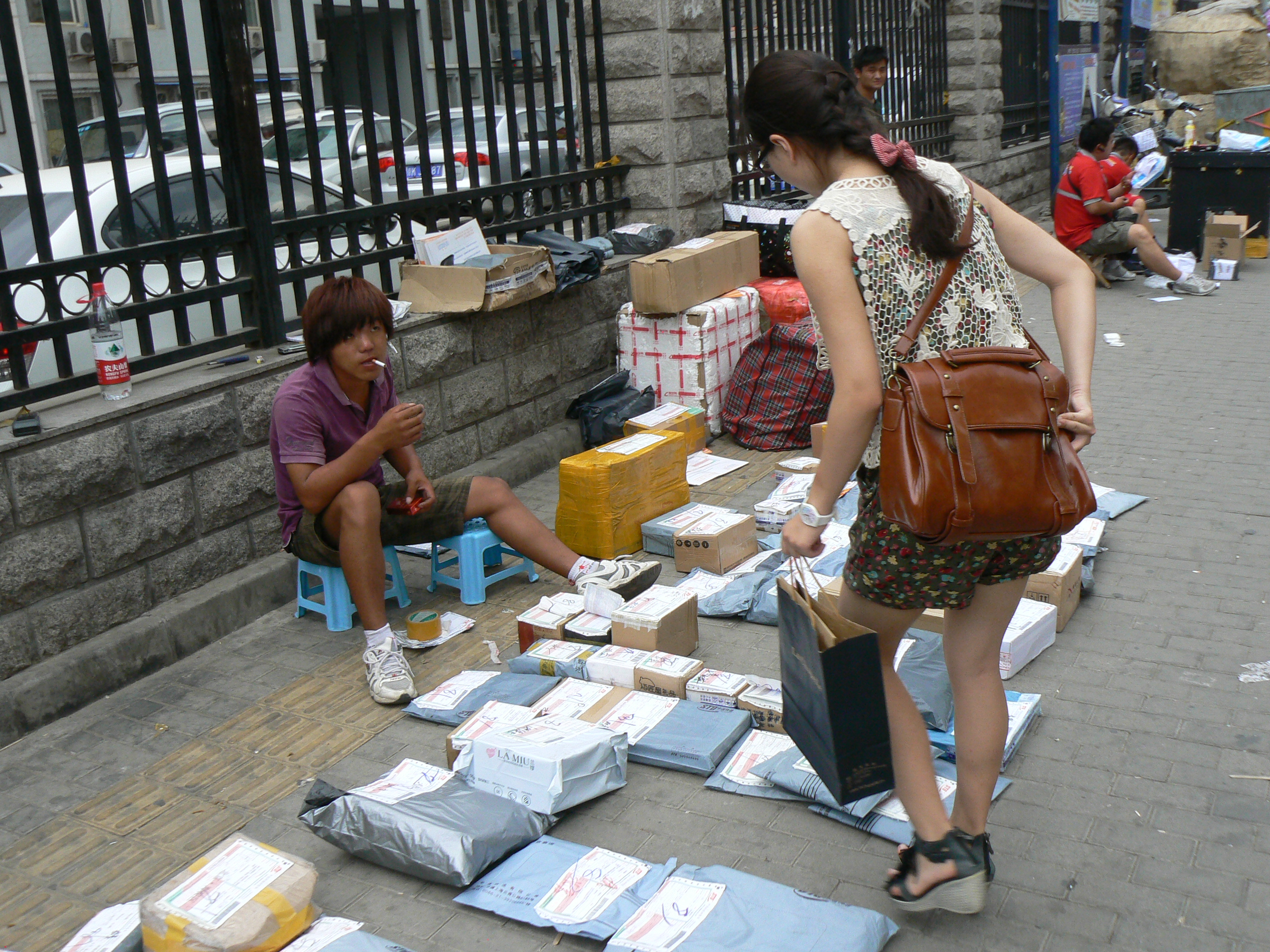
And if you’re going to do all this stuff on the street you also have to clean the streets… (Beijing)

But cleanliness only goes so far. Chinese streets are pretty dangerous. Fortunately, there are normally lots of people who want to cross them, so one joins the pack, then hops across lane by lane. Hopefully, someone else gets picked off by the speeding car. So it works, and traffic lights become somewhat optional, but it can be a tad unnerving. Nobody takes the laws too seriously. Cars crowd into the buses only lane. Bus riders flout the wear-a-seatbelt rule, partly because they seem to think the contraptions a bit foreign. (I had to show one grandmother, who didn’t even speak Mandarin, how to put one on.) The authorities respond by checking that the belts are on before you leave the bus depot (at least in Yunnan), so everyone buckles up for a minute and then unbuckles. Of course, there are some accidents… and then you get to see citizens arguing with the police.
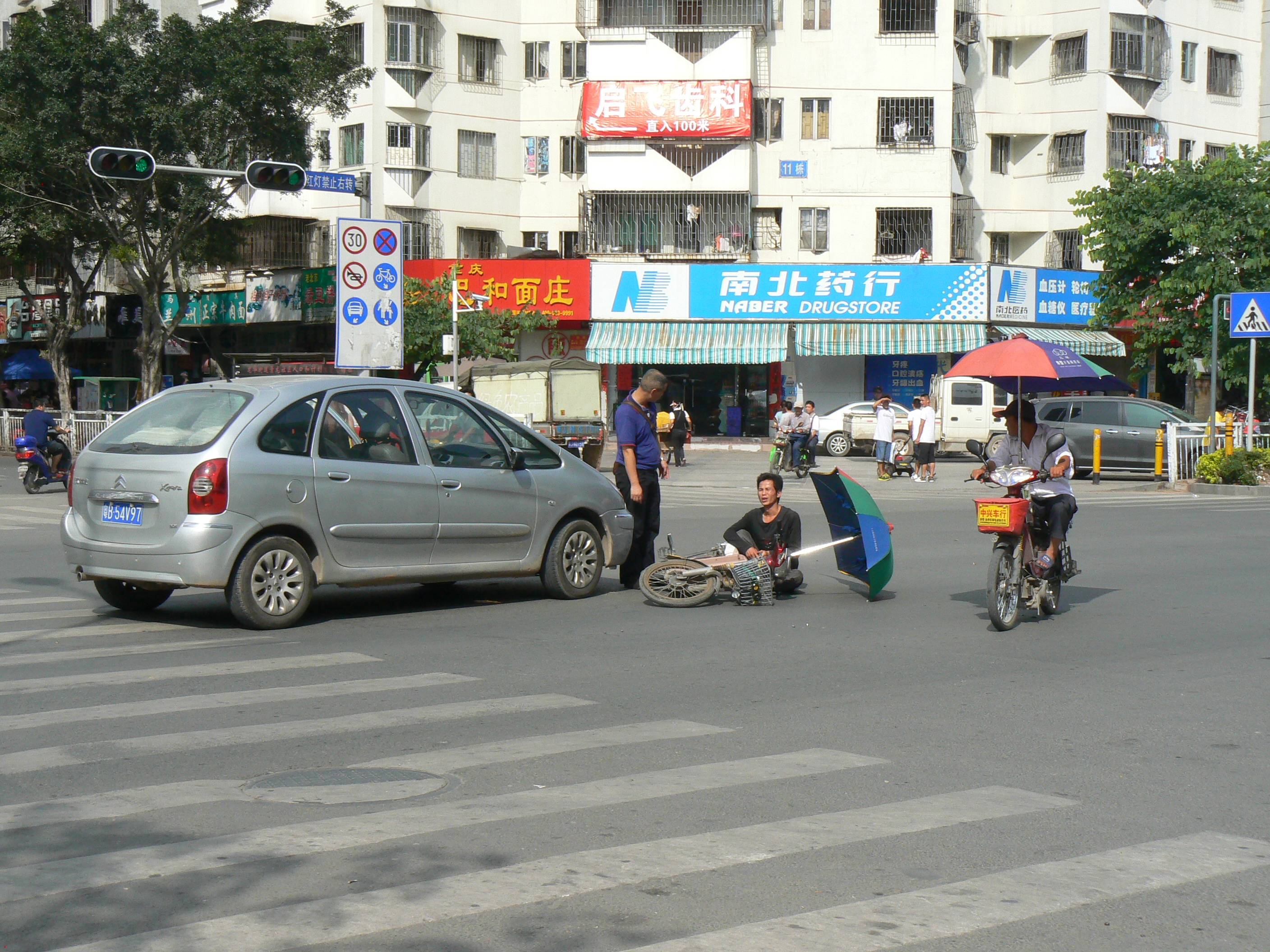
Still, most of the time the roads just work. Besides the lane-hopping pedestrians (e.g., me), they squeeze in cars and buses. And then there are the electric motorbikes… lots of cities have banned real motorbikes for environmental reasons, and regular bikes are just too old fashioned, but electric motorbikes are wildly popular in some places (although not up to Vietnamese standards, where traffic flow is essentially a fluid of electric bikes). And they can really kill you: they’re quiet. They also can be pretty versatile… (Kunming)
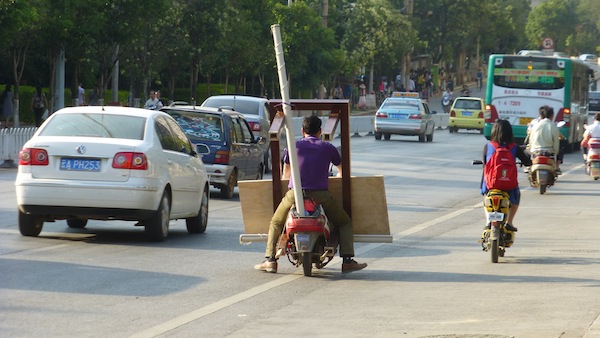
Notwithstanding Chinese planners’ best efforts, the cities are not quite entirely paved. Every city has one–or often a handful of–really nice parks. These attract plenty of people out for a stroll, but they tend to be dominated by the elderly, who bring loud music and dance or practice taichi. They do this in city squares too. I love it, but it can drive the locals nuts: in fact, there have been a spate of violent rampages against too-noisy crowds of dancing seniors. (Cuihu, Kunming)

Not all the seniors in the parks are dancing. They also have to do important business: finding their kids and grandkids spouses. Here’s a collection of spouse-wanted posters, specifying the desired dimensions, employment, etc. (Chengdu)
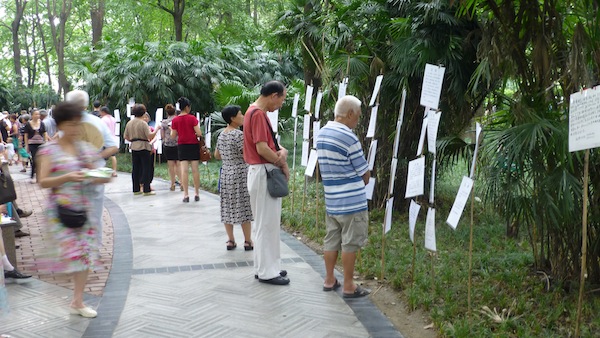
Although studying Chinese is something of a full time job, it really doesn’t require being near the classroom. The vast majority of locals are only going to carry on a conversation in Chinese (some overzealous high-schoolers excepted). So sightseeing can legitimately be counted as studying. The big risk is that, if you venture too far out into the countryside, people won’t even be speaking Mandarin, either.
Traveling (for me at least) tends to start in a big train station. They aren’t normally as crowded as this one in Tianjin–they’re universally brand new, and all enormous–we’re talking 20 to 30 tracks, rarely filled with trains. When I first was in China in 2012, almost all the stations I went to were deserted. Now they’re starting to get busier… you get used to big things fast in China, and you get used to change.
And big things can also be quite pretty. Here’s a snow sculpture from the annual Harbin Snow & Ice Festival. And yes, those are people walking around on it.
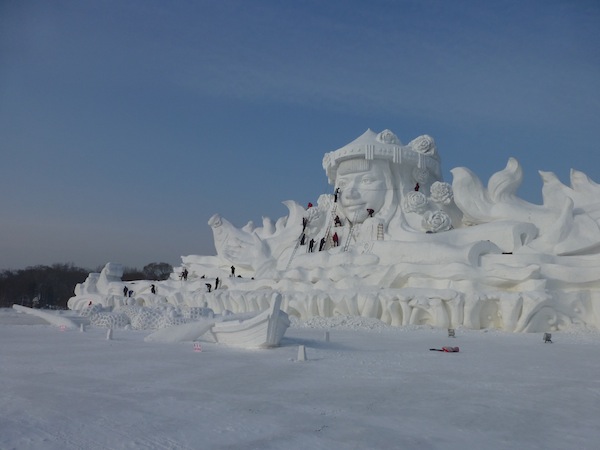
Harbin is about as far north as you can get without being in Russia–it’s north of Vladivostok (but south of Paris!)–and indeed has been Russian (see the Russian Orthodox Church downtown, since converted to a museum after rather serious neglect during the Great Leap Forward and Cultural Revolution). Anyway, every year Harbin attracts Chinese tourists from all over the country to come and freeze looking at enormous snow sculptures, intricate ice sculptures, and a veritable city subdivision made of ice. Getting there was a bit of a pain for me. Chinese train tickets sell out quickly the closer one gets to Chinese New Year (this year I swear I saw a train sell out within 30 seconds of opening sales), tickets to Harbin kept selling out before I could get to the front of the ticket queue. I eventually bought them online… Getting off the train in Harbin I realized I might have made a mistake: my mustache froze as I encountered a 90ºF temperature change from the train to outdoors. The rest of my time in Harbin (low: -30ºC) was cold, er, frostbitten. But well worth it. Even if the cabs there really try to swindle you.
Skipping to the opposite corner of the (populated part of the) country, here are the Yuanyang rice terraces in Yunnan (元阳梯田), about to fall over the border into Vietnam.
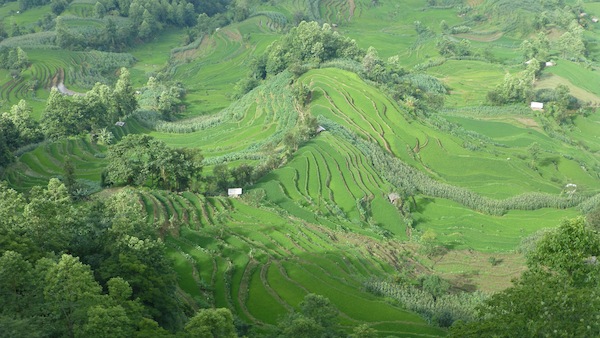
So I visited them (with my dad) after some sightseeing in Vietnam. We woke up at the crack of dawn and headed for the Vietnam-China border, where we encountered some black-market money changers and a lot of merchants taking lychees and other fruits across into China to sell them wholesale on the streets to Chinese buyers. When the border crossing opened, they literally charged across to get first access to the market. We should have too. We almost missed our dinky twenty-seater bus, which (except for some rough patches through banana plantations and up mountains) cruised along big divided highways for much of the journey. This in the middle of nowhere: the infrastructure can be quite amazing.
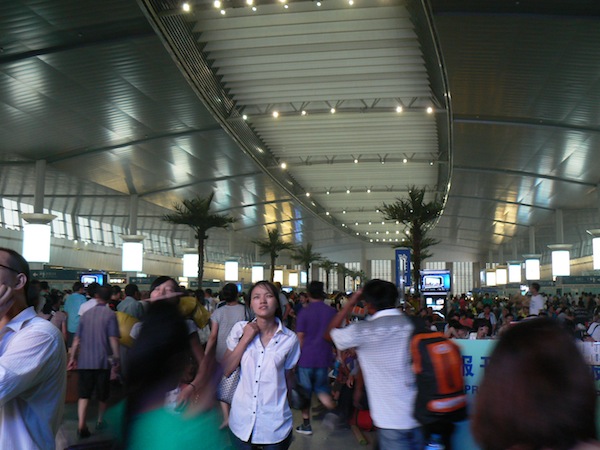
Yuanyang is part of an “autonomous” minority prefecture for the Hani and Yi peoples, and the center of the rice terraces tourist area is a former county seat that continues to serve as a major market town. So out in full force were crowds of locals in local dress, including plenty with live chickens. I stopped for the local rice noodles (米线) at a little restaurant only to discover a couple of live chickens falling over my feet. Here they perch in someone’s basket.

Some sights in China you might actually have heard of. Here’s the GIANT Buddha at Leshan (乐山)–keep in mind that those are full-grown trees on the walls. Just on the other side of the hill is a modern Buddha sculpture garden (mostly deserted) with only slightly smaller Buddhist statues mimicking those at other famous Chinese sites. Since it’s a major tourist site (and hence cram-packed with slow-moving people), getting there wasn’t hard. Getting out was a tad more difficult, as I dawdled and treated myself to dinner at a local restaurant before trying to find the bus back to Emei (my bed). Fortunately, before I found the bus station, which closed well before dark, I found the public park, complete with huge crowd of dancers and a couple of girls giggling about the foreigner passing by. I somehow scared them into thinking I knew some Chinese, at which point I was roped into a photo and offered help getting back to Emei… so they negotiated a cab for me while I (the foreigner, a tempting target on whom to raise the price) hid in the background. Being a foreigner can be quite easy at times…
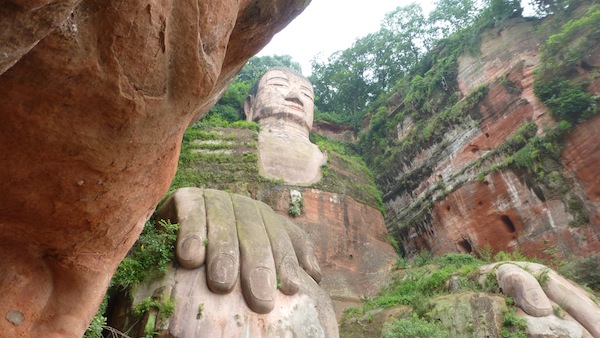
Back to Yunnan for Puzhehei (普者黑), where I ventured out on a weekend between classes. (This didn’t afford much time to actually be there. I had to take a bus to the prefectural seat, sleep the night in a hotel that had run the internet wiring on the outside of the building, then another bus to the county seat, and a walk–a bus did exist–out to the village/tourist resort. Coming back I found myself on a bus armed with beds–for a daytime ride. Quite awkward lying down. On my top bunk.) Puzhehei is a truly Chinese tourist town. I was the only foreigner I saw there (plenty of photos taken of me by people who thought I didn’t notice), and the Chinese tourists were in standard form: they stayed at ground level on paved paths. Hence most people did not get to see this view. Also, as is typical in China, my hotel had a “massage parlor” complete with room service advertised by a photo of an almost naked-girl stuck next to my bed. On the door was the police sign admonishing visitors against prostitution.
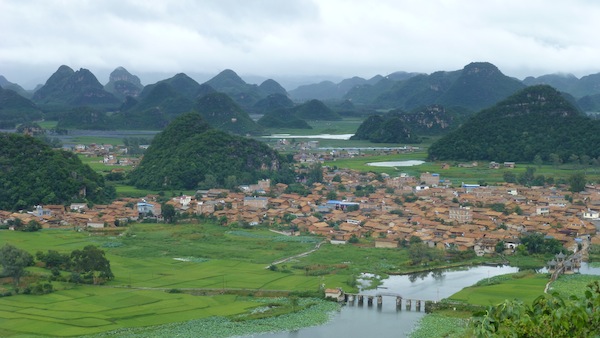
Speaking of signs, they are everywhere, and often pretty funny. The best are often what would in English just say “Stay off the grass.” (Runner up for this spot in the blog was “BEWARE OF YOUR CHILDREN!”)
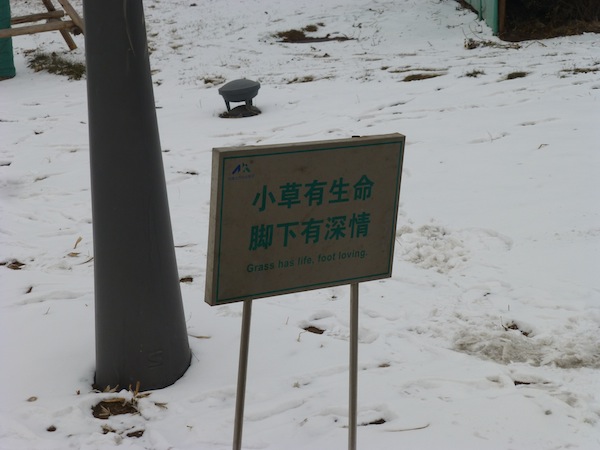
Not all signs are funny without context. My first summer in China, Beijing was hit by a record-breaking thunderstorm that resulted in significant flooding (and a few deaths), particularly in Fangshan 房山, a district southwest of the downtown. Some western media implicitly forecast the impending fall of the regime based upon the loss of legitimacy traditionally implied by poorly handled natural disasters. The journalist-astrologers were proven wrong. But when I decided to spend an afternoon after class going to investigate, I got to see not only 750,000 year old Peking Man but also this streetscape. The sign, of the typical red banner variety, remarks that “Communist Party members should stand at the forefront of flood recovery from start to finish.” Not much news there. But what’s the stuff in front of it drying on the street? Noodles. I kid you not.
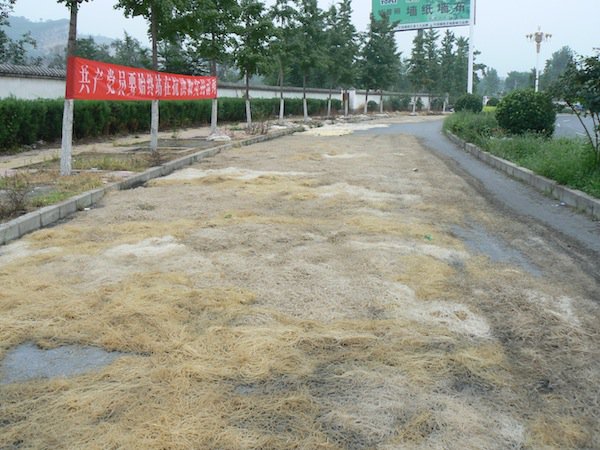
And as a parting gift… my favorite pedestrian overpass in Beijing.
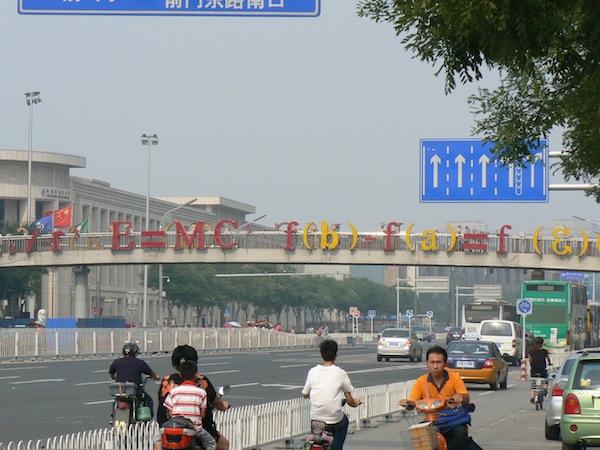
HOW THIS GOT FUNDED:
Three of my four trips to China were for Chinese language classes: once in Beijing at CET, once in Tianjin at New Century, and once in Kunming at CET. These were all funded by the MIT Global Education Office, which I heard about through the rare useful piece of spam jammed into my inbox by the Math Department. They had me fill out a very short two page application, after which I was given funding for my airfare and tuition–if you ask, you can also sometimes get living costs covered. I repeated this for the next two trips.
The fourth trip was for research, so some persistence won me departmental funding for the exercise.
The next and fifth trip will be to study Chinese after I graduate. MIT is guaranteed four Chinese Government Scholarships to cover students who enroll in Chinese universities for degree or non-degree programs. I’ll be enrolling at Peking University, and as the only person from MIT who bothered to apply, didn’t have too much to worry about in terms of getting funding.
In short, the humanities at MIT are not crowded–so you can get treated quite well financially!